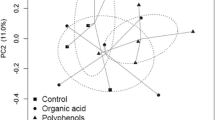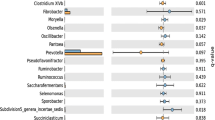Abstract
Reindeer are animals adapted to live in a poor diet and low temperatures in the Arctic regions. The aim of this research was to study the biodiversity of ruminal microorganisms of Rangifer tarandus inhabiting the Murmansk region, Russian Federation. Samples of the ruminal contents from 11 individuals, incl. young (YA, n = 3), mature (MA, n = 4) and old (OA, n = 4) animals were used for the research. The ruminal bacterial community of reindeer was studied using the T-RFLP (Terminal restriction fragment length polymorphism) method. A significant number of DNA sequences in the rumen of Rangifer tarandus were classified as uncultured bacteria (up to 69.88%), the largest share of which was found in groups YA and OA. The representation of several taxa had age differences: in individuals of the MA group, the share of Lachnospiraceae, Eubacteriaceae, Thermoanaerobacteriaceae, Ruminococcaceae increased and in the AO group the share of Clostridiaceae increased. It was important to note in the rumen of reindeer the presence of various diseases pathogens and their association with a certain age of animals: Campylobacteraceae was noted in the YA group; Enterobacteriaceae, Pseudomonadaceae, and Pasteurellaceae in the MA group; Staphylococcus sp., Tenericutes, Fusobacteria, Actinobacteria in the OA group. In general, according to the alpha-diversity index values of ruminal microorganisms (taxonomic units, Shannon's index), a tendency toward a decrease in biodiversity and an increase in its homogeneity was revealed increasing age in reindeer.
Access this chapter
Tax calculation will be finalised at checkout
Purchases are for personal use only
Similar content being viewed by others
References
Aagnes, T.H., Sørmo, W., Mathiesen, S.D.: Ruminal microbial digestion in free living, in captive lichen-fed and in starved reindeer (Rangifer tarandus tarandus) in winter. Appl. Env. Microb. 61(2), 583–591 (1995). https://doi.org/10.1128/AEM.61.2.583-591.1995
Johnson, K.A., Johnson, D.E.: Methane emissions from cattle. J. Anim. Sci. 73, 2483–2492 (1995). https://doi.org/10.2527/1995.7382483x
Tadepalli, S., Narayanan, S.K., Stewart, G.C., Chengappa, M.M., Nagaraja, T.G.: Fusobacterium necrophorum: a ruminal bacterium that invades liver to cause abscesses in cattle. Anaerobe 15(1–2), 36–43 (2009). https://doi.org/10.1016/j.anaerobe.2008.05.005
Church, D.C.: Ruminant Animal: Digestive Phisiology and Nutrition. Prentice Hall, New Jersey (1993)
Hungate, R.E.: The Rumen and its Microbes. Academic Press, NY (1966). https://doi.org/10.1002/jobm.19690090617
De la Fuente, G., Belanche, A., Girwood, S.E., Pinloche, E., Wilkinson, T., Newbold, C.J.: Pros and cons of ion-torrent next generation sequencing versus terminal restriction fragment length polymorphism T-RFLP for studying the rumen bacterial community. PLoS ONE 9(7), e101435 (2014). https://doi.org/10.1371/journal.pone.0101435
Roach, J.A.G., Musser, S.M., Morehouse, K., Woo, J.Y.J.: Determination of usnic acid in lichen toxic to elk by liquid chromatography with ultraviolet and tandem mass spectrometry determination. J. Agric. Food Chem. 54, 2484–2490 (2006). https://doi.org/10.1021/jf052767m
Eckard, R.J., Grainger, C., de Klein, C.A.M.: Options for the abatement of methane and nitrous oxide from ruminant production: a review. Livest. Sci. 130, 47–56 (2010)
Martin, C., Morgavi, D.P., Doreau, M.: Methane mitigation in ruminants: from microbe to the farm scale. Anim. Int. J. Anim. Biosci. 4(3), 351–365 (2010) https://doi.org/10.1017/S1751731109990620
Layshev, K.A., Ilina, L.A., Yildirim, E.A., Philippova, V.A., Dunyashev, T.P., Dubrovin, A.V., Sobolev, D.V., Novikova, N.I., Laptev, G.Yu., Yuzhakov, A.A., Romanenko, T.M., Vylko, Yu.P.: The rumen microbiota of reindeer (Rangifer tarandus) with clinical manifestations of necrobacteriosis. Sel’skokhozyaistvennaya Biologiya [Agricultural Biology] 54(4), 744–753 (2019). https://doi.org/10.15389/agrobiology.2019.4.744eng
Li, Y., Hu, X., Yang, S., Zhou, J., Qi, L., Sun, X., Fan, M., Xu, S., Cha, M., Zhang, M., Lin, S., Liu, S., Hu, D.: Comparison between the fecal bacterial microbiota of healthy and diarrheic captive musk deer. Front. Microbiol. 9, 300 (2018). https://doi.org/10.3389/fmicb.2018.00300
Nocek, J.E.: Bovine acidosis: implications on laminitis. J. Dairy Sci. 80, 1005–1028 (1997). https://doi.org/10.3168/jds.S0022-0302(97)76026-0
Sambrook, J.: Molecular Cloning: a Laboratory Manual. Cold Spring Harbor Laboratory Press, New York (2001). https://doi.org/10.1021/jf052767m
Mukhachev, A.D., Layshev, K.A.: The World of Reindeer. Norilsk, Russia (2007)
Wang, L., Xu, Q., Kong, F., Yang, Y., Wu, D., Mishra, S., Li, Y.: Exploring the goat rumen microbiome from seven days to two years. PLoS ONE 11(5), e0154354 (2016). https://doi.org/10.1371/journal.pone.0154354
Zielińska, S., Kidawa, D., Stempniewicz, L., Łoś, M., Łoś, J.M.: New insights into the microbiota of the Svalbard Reindeer Rangifer tarandus platyrhynchus. Front. Microbiol. 7, 170 (2016). https://doi.org/10.3389/fmicb.2016.00170
Weimer, P.J.: Redundancy, resilience, and host specificity of the ruminal microbiota: implications for engineering improved ruminal fermentations. Front. Microbiol. 6, 1–16 (2015). https://doi.org/10.3389/fmicb.2015.00296
Ishaq, S.L., Wright, A.-D.G.: Insight into the bacterial gut microbiome of the North American moose (Alces alces). BMC Microbiol. 12, 212 (2012). https://doi.org/10.1186/1471-2180-12-212
Samsudin, A.A., Evans, P.N., Wright, A.G., Al Jassim, R.: Molecular diversity of the foregut bacteria community in the dromedary camel (Camelus dromedarius). Environ. Microbiol. 13, 3024–3035 (2011). https://doi.org/10.1111/j.1462-2920.2011.02579.x
Sundset, M.A., Kohn, A., Mathiesen, S.D., Præsteng, K.E.: Eubacterium rangiferina, a novel usnic acid-resistant bacterium from the reindeer rumen. Naturwissenschaften 95, 741–749 (2008). https://doi.org/10.1007/s00114-008-0381-0
Hansen, K.K., Sundset, M.A., Folkow, L.P., Nilsen, M., Mathiesen, S.D.: Methane emissions are lower from reindeer fed lichens compared to a concentrate feed. Polar Res. 37, 1 (2018). https://doi.org/10.1080/17518369.2018.1505396
Blaxter, K.L., Clapperton, J.L.: Prediction of the amount of methane produced by ruminants. Br. J. Nutr. 19, 511–522 (1965). https://doi.org/10.1079/bjn19650046
Henderson, G., Cox, F., Ganesh, S., Jonker, A., Young, W., Janssen, P.H.: Rumen microbial community composition varies with diet and host, but a core microbiome is found across a wide geographical range. Sci. Rep. 5, 14567 (2015). https://doi.org/10.1038/srep14567
Murtagh, F., Legendre, P.: Ward’s hierarchical agglomerative clustering method: which algo-rithms implement ward’s criterion? J. Classif. 31(3), 274–295 (2014). https://doi.org/10.1007/S00357-014-9161-Z
Acknowledgements
Supported financially by Russian Science Foundation for project No. 17-76-20026 «Rumen microbiocenosis in Rangifer tarandus of the Russian Arctic as a fundamentals for promising animal biotechnologies».
Author information
Authors and Affiliations
Corresponding author
Editor information
Editors and Affiliations
Rights and permissions
Copyright information
© 2022 The Author(s), under exclusive license to Springer Nature Singapore Pte Ltd.
About this paper
Cite this paper
Ilina, L., Filippova, V., Yildirim, E., Laptev, G., Laishev, K. (2022). Profiling of Reindeer’s Rumen Microbial Communities: Characteristics and Age-Related Analysis. In: Ronzhin, A., Berns, K., Kostyaev, A. (eds) Agriculture Digitalization and Organic Production . Smart Innovation, Systems and Technologies, vol 245. Springer, Singapore. https://doi.org/10.1007/978-981-16-3349-2_6
Download citation
DOI: https://doi.org/10.1007/978-981-16-3349-2_6
Published:
Publisher Name: Springer, Singapore
Print ISBN: 978-981-16-3348-5
Online ISBN: 978-981-16-3349-2
eBook Packages: Intelligent Technologies and RoboticsIntelligent Technologies and Robotics (R0)




